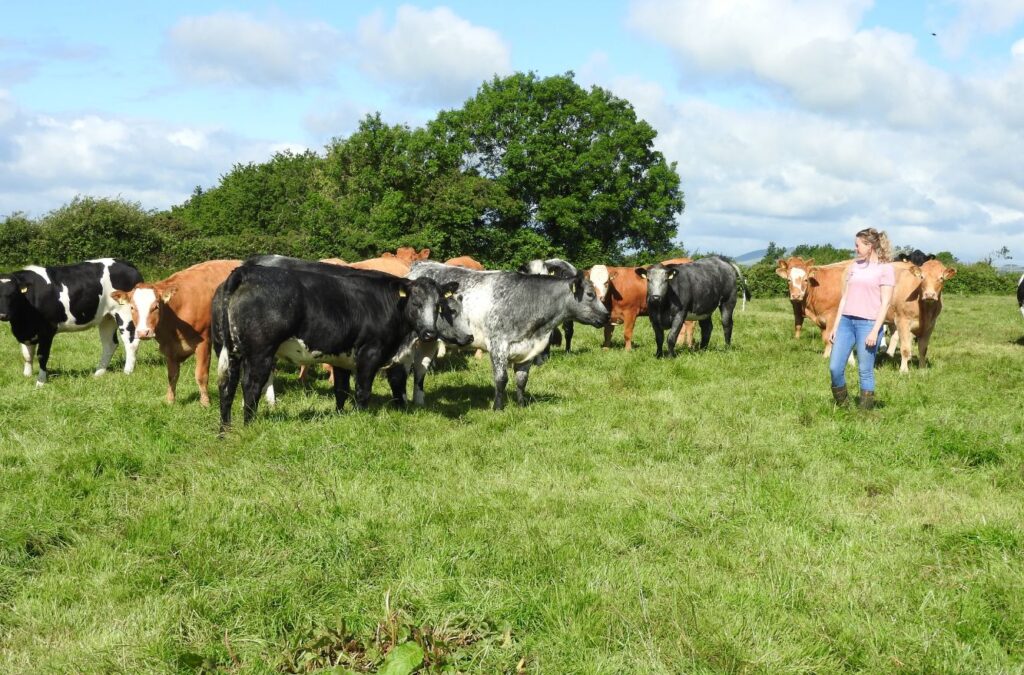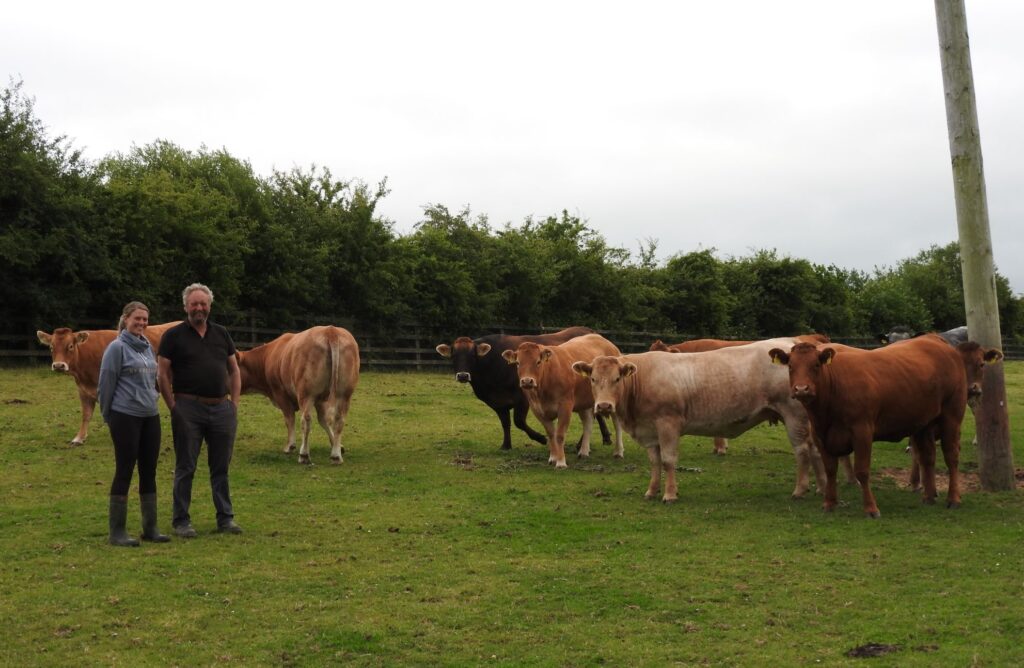That’s Farming editor, Catherina Cunnane, in conversation with full-time farmer, Debbie Sunderland (30), in this week’s women in ag segment. She discusses how a brief stint in New Zealand made her realise that farming is her call, running a 120-cow suckler enterprise and 120-acre tillage enterprise, a 3-month calving interval, passion for Belgian Blues and reducing cow numbers.
“I am the fifth-generation of Sunderlands to farm in Aske, Gorey, Co Wexford.
As a child, I always loved to be out on the farm, but as I grew older and through my teenage years, I fell under the perception that farming was very much so a male role.
I suppose I just did not consider that it was something that I, as a young woman, could take on. In 2013, I travelled to New Zealand, and within three weeks, I rang home and told my father that I wanted to farm when I returned.
To this day, I have no idea what caused the penny to drop with me, but that is exactly what I did, and I have been full-time farming ever since I came home in 2014.
I started out farming alongside my father, Fred, great-uncle, Des, and grandfather, Sidney.
They showed me the ins and outs of farming, cattle handling, operating machinery, herding, water maintenance and fencing etc.
They were very particular about teaching me the workings of tools such as the sprong and yard brush.
I found handling these tools to their satisfaction took a lot of practice. I also set about getting my Green Cert and completed that in 2017.
Full-time farmer
Now eight years on, I work alongside my father, Fred, and we run under the company name FDH Farms.
I am still learning from him daily, and luckily daddy is always open to considering new ideas in farming and to letting me find my own feet in the running of the farm in the future.
We have around 120-acres of tillage, largely consisting of barley and fodder beet, which we mainly use for supplying our beef enterprise.
My uncles, Paul, and Blake, also have their own enterprises on-farm, these being growing vegetables and breeding Thoroughbred horses.

Suckler farming
In the past eight years, our commercial suckler herd has been in or around 120 cows, and up to this year, we had been calving half the herd in autumn months and the other half in spring.
As of this year, we have now fully changed over to all autumn calving and are practicing being quite strict on our calving interval of 3 months (August-September-October).
This means we have relatively hardy calves coming into the house for the winter months.
We are streamlining feeding/finishing our cattle with fewer but larger groups and are halving our time spent calving each year.
Cow types and bull selection
Our cows are mostly a mix of Simmental and Limousin-cross with a shake of Belgian Blue and Charolais- cross cows.
We run Belgian Blue and Limousin bulls, but we also use some AI on our heifers. For the latter, we utilise teaser bulls to detect heats and mop up with an easy-calving Simmental or Limousin bull.
It is hard for me to choose my preferred cow type as I think it is very much so down to the individual animal and how they breed when crossed with a particular bull.
That being said, I believe it is hard to beat Belgian Blue in the breeding for putting power into calves.
No matter what batch of animals I am looking at on-farm, it is always the blues that I find myself admiring.
Finishing progeny
We tend to finish almost all our stock, and this year we have joined the Advantage Beef Programme with ABP.
We aim to finish our bulls under 16 months, and the ideal candidates finish at approx. 720 kilos live weight (420 kilos carcass weight) with a fat score of 2+ to 4+.
Naturally enough, these figures are not always met with some animals and sometimes exceeded with others, but we try our best to target these figures.
In general, we finish our heifers at 30 months, giving them time to grow to a decent size. They usually fall in or around 390 kilos carcass weight, but again, this varies depending on the animal.
We also finish our cull cows. I am inclined to destine them for a trip on the lorry if they prove very ill-mannered after calving.
Otherwise, we base culling mostly on age, poor progeny, fertility, or udder issues.

Replacement females and age of first calving
Alongside purchasing cattle to finish, we also buy in most of our replacement heifers but have begun keeping some of our own Belgian Blue-cross heifers in the past few years.
To date, they have worked out for us, although, this year, we have kept some strong blues, and the closer they get to calving, I find myself wondering have I been too brave in some of my selections.
Time will tell, and besides, nothing ventured, nothing gained.
As for calving our heifers, despite all recommendations of calving at two years of age, it is something we are quite strongly against. We like our heifers to be two-and-a-half (30 months) calving down.
We believe this gives our heifers time to mature, making calving and rearing less stressful for the heifer and increases her chances going forward as being a long-standing animal in the herd.
Our grassland management is something which has room for improvement. At present, we measure by eye, and we use temporary paddocks.
We usually top after grazing, weather permitting and use a leader-follower system, moving on the young stock when the best of the leaf is grazed and letting the dry cows pull off the remainder.
This also helps to manage our dry cows feed intake in the eight weeks before calving.

Satisfaction
Without any hesitation, I can say the stock are my favourite part of farming. As much as I enjoy a day baling, mowing or topping (provided the machine behaves itself), nothing gives me the same satisfaction as working amongst the stock.
Daddy does most of the machinery work on-farm, which suits both him and me. As for machinery maintenance, I am afraid my patience is slim to none so much.
Having to loosen off bolts has me in foul humour, so luckily for me, daddy is good at that sort of work.

Reducing numbers
Going forward, I am hoping to reduce our cow numbers. My thinking is less quantity and more quality.
I have come to notice that reduction is almost seen as a dirty word in the world of farming, and to be honest; honestly, I have even struggled to mention that it is something I am working towards.
I believe, money aside, that it is a lot easier for a farmer to get bigger rather than smaller.
Getting smaller takes guts; it goes against the grain for us, and I think it is partially a pride thing.
I recently had to go through our cows to pick out a handful to sell in-calf, and as it is something we have never done before, I found it extremely tough, almost to the point of emotional.
I regret that getting smaller is something we need to do, but as much as I love farming and could not imagine doing anything else, there are other things I enjoy and want to have time for in life. Decreasing the workload is the only way to achieve that.

Reflection
If I were to take heed of all the negativity, I hear day in, day out about the future of suckler farming in Ireland, I dare say I would have packed it in by now.
Luckily, I am not in farming to make a fortune; I do it because it is what I love to do, and I would rather hedge my bets at making a living doing what I love than doing something I am not passionate about for the sake of a hefty pay packet.
We feel that by continuing to improve our stock quality, better utilisation of grass and applying for any beef/suckler schemes available, we have a future in Suckler/Beef farming.
Also, we are considering the AECM scheme under the new CAP. We feel it could be a win-win situation for farmers and the environment.
I am delighted to see that more and more female faces seem to be appearing in the agricultural sector.
Based on my own experience, I think it is extremely important to pursue the career you are passionate about, whether the rest of society sees it as suited to you or not.
Presently, I would say coming home to the farm is one of the best decisions I have made for myself so far in life. Hopefully, I will still be stating that in another thirty years.”
To share your story like this full-time farmer, email – [email protected]
See more women in ag profiles.





